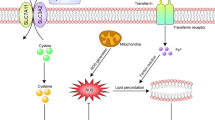Abstract
Glaucoma is a group of disease characterized by progressive optic nerve degeneration and retinal ganglion cells (RGCs). The RGCs and evaluation elevated intraocular pressure are the most common cause for glaucoma. In this study, RGC death pathway of glaucoma was modeled to predict the response of the protein receptor, ligand, inhibitor and other regulatory units, which are involved in RGC death pathway in glaucoma. In the pathway modeling six aspects were considered, namely extrinsic pathway, intrinsic pathway, endoplasmic reticulum stress, neurotrophins signaling response, oxidative stress response and calpain activation induced RGC degeneration. The pathway has been designed a compressive pathway of molecular interaction on a cellular level based on published literature for analyzing the expression of the species. The CellDesigner software was used to designing the pathway and store it systems biology markup language (SBML). The SBML squeezer plugin is used to apply the kinetic equation such as a general mass action equation, Michaelis–Menten equation, and Hill equation for pathway simulation. The pathway of glaucoma was showed the over/down expression of the protein species.





Similar content being viewed by others
References
Almasieh M, Wilson AM, Morquette B, Vargas JLC, Di Polo A (2012) The molecular basis of retinal ganglion cell death in glaucoma. Prog Retinal Eye Res 31(2):152–181
Awai-Kasaoka N, Inoue T, Kameda T, Fujimoto T, Inoue-Mochita M, Tanihara H (2013) Oxidative stress response signaling pathways in trabecular meshwork cells and their effects on cell viability. Mol Vis 19:1332
Berkelaar M, Clarke DB, Wang YC, Bray GM, Aguayo AJ (1994) Axotomy results in delayed death and apoptosis of retinal ganglion cells in adult rats. J Neurosci 14(7):4368–4374
Brett BH, Mueller II, Stankowska Dorota L, Krishnamoorthy Raghu R (2011) Neuroprotection in glaucoma. Glaucoma–basic and clinical concepts. InTech Open Sci 10(7):5772–5792
Dräger A, Hassis N, Supper J, Schröder A, Zell A (2008) SBMLsqueezer: a CellDesigner plug-into generate kinetic rate equations for biochemical networks. BMC Syst Biol 2(1):39
Garcia Valenzulela E, Gorczyca W, Darzynkiewicz Z, Sharma SC (1994) Apoptosis in adult retinal ganglion cells after axotomy. J Neurobiol 25(4):431–438
Huang W, Fileta JB, Dobberfuhl A, Filippopolous T, Guo Y, Kwon G, Grosskreutz CL (2005) Calcineurin cleavage is triggered by elevated intraocular pressure, and calcineurin inhibition blocks retinal ganglion cell death in experimental glaucoma. Proc Natl Acad Sci USA 102(34):12242–12247
Izzotti A, Bagnis A, Saccà SC (2006) The role of oxidative stress in glaucoma. Mutat Res Rev Mutat Res 612(2):105–114
Jing G, Wang JJ, Zhang SX (2012) ER stress and apoptosis: a new mechanism for retinal cell death. Exp Diabetes Res 2012:589589. doi:10.1155/2012/589589
Johnson EC, Guo Y, Cepurna WO, Morrison JC (2009) Neurotrophin roles in retinal ganglion cell survival: lessons from rat glaucoma models. Exp Eye Res 88(4):808–815
Kurji K, Sharma RK (2010) Potential role of calcineurin in pathogenic conditions. Mol Cell Biochem 338(1–2):133–141
Liu Q, Ju WK, Crowston JG, Xie F, Perry G, Smith MA, Weinreb RN (2007) Oxidative stress is an early event in hydrostatic pressure–induced retinal ganglion cell damage. Investig Ophthalmol Vis Sci 48(10):4580–4589
NunÄez G, Benedict MA, Hu Y, Inohara N (1998) Caspases: the proteases of the apoptotic pathway. Oncogene 17:3237–3245
Qu J, Wang D, Grosskreutz CL (2010) Mechanisms of retinal ganglion cell injury and defense in glaucoma. Exp Eye Res 91(1):48–53
Roh M, Zhang Y, Murakami Y, Thanos A, Lee SC, Vavvas DG, Miller JW (2012) Etanercept, a widely used inhibitor of tumor necrosis factor-α (TNF-α), prevents retinal ganglion cell loss in a rat model of glaucoma. PLoS One 7(7):e40065
Sano R, Reed JC (2013) ER stress-induced cell death mechanisms. Biochim Et Biophys Acta (BBA) Mol Cell Res 1833(12):3460–3470
Zode GS, Sharma AB, Lin X, Searby CC, Bugge K, Kim GH, Sheffield VC (2014) Ocular-specific ER stress reduction rescues glaucoma in murine glucocorticoid-induced glaucoma. J Clin Investig 124(5):1956–1965
Author information
Authors and Affiliations
Corresponding author
Ethics declarations
Financial support and sponsorship
Nil.
Conflict of interest
There are no conflicts of interest.
Rights and permissions
About this article
Cite this article
Choudhari, J.K., Choubey, J., Patel, A. et al. Molecular modeling and simulation analysis of glaucoma pathway. Netw Model Anal Health Inform Bioinforma 5, 29 (2016). https://doi.org/10.1007/s13721-016-0136-3
Received:
Revised:
Accepted:
Published:
DOI: https://doi.org/10.1007/s13721-016-0136-3




